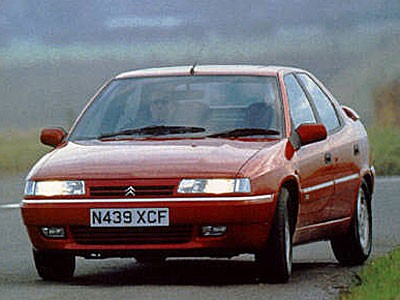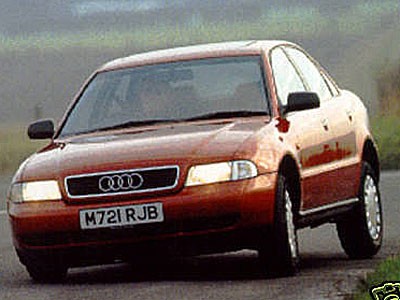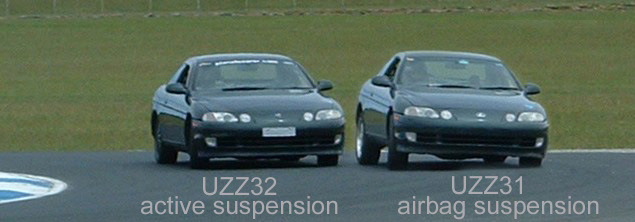Moose test anyone
Discussion
Max_Torque said:
er, it's a "lets just make up a complete load of random numbers" test then.... A Kia C'eed is the same as the Exige???
And as for the Activa, "active" suspension isn't actually any "better" than non active suspension. The cars lateral weight transfer (and hence ability to keep all 4 tyres evenly loaded on the slip vs lateral g curve) is set purely by it's track, mass, and C of G height (for static case) So no matter how "stiff" the suspension on an Activa is, it's not much help really, when compared to the Exige???
Wrong. Active suspension means that even under harsh cornering, the car works the suspension such that the contact patch remains optimum, putting much more rubber on the road. Comparative cornering pictures of a Xantia and an A4 in the link below to show what I mean.And as for the Activa, "active" suspension isn't actually any "better" than non active suspension. The cars lateral weight transfer (and hence ability to keep all 4 tyres evenly loaded on the slip vs lateral g curve) is set purely by it's track, mass, and C of G height (for static case) So no matter how "stiff" the suspension on an Activa is, it's not much help really, when compared to the Exige???
http://www.pistonheads.com/doc.asp?c=162&i=205...


It's actually capable of higher sustained cornering G than an Honda NSX...
Max_Torque said:
er, it's a "lets just make up a complete load of random numbers" test then.... A Kia C'eed is the same as the Exige???
And as for the Activa, "active" suspension isn't actually any "better" than non active suspension. The cars lateral weight transfer (and hence ability to keep all 4 tyres evenly loaded on the slip vs lateral g curve) is set purely by it's track, mass, and C of G height (for static case) So no matter how "stiff" the suspension on an Activa is, it's not much help really, when compared to the Exige???
If the test is effectively a "slalom" test, and the "passing" criteria is max speed without spinning, then cars with stability control (and the massive yaw authority that gives) will easily "outperform" even a pretty sporting car without. That may explain some of the results??
You've never driven a car with active suspension before have you.And as for the Activa, "active" suspension isn't actually any "better" than non active suspension. The cars lateral weight transfer (and hence ability to keep all 4 tyres evenly loaded on the slip vs lateral g curve) is set purely by it's track, mass, and C of G height (for static case) So no matter how "stiff" the suspension on an Activa is, it's not much help really, when compared to the Exige???
If the test is effectively a "slalom" test, and the "passing" criteria is max speed without spinning, then cars with stability control (and the massive yaw authority that gives) will easily "outperform" even a pretty sporting car without. That may explain some of the results??
BlueMR2 said:
Max_Torque said:
er, it's a "lets just make up a complete load of random numbers" test then.... A Kia C'eed is the same as the Exige???
And as for the Activa, "active" suspension isn't actually any "better" than non active suspension. The cars lateral weight transfer (and hence ability to keep all 4 tyres evenly loaded on the slip vs lateral g curve) is set purely by it's track, mass, and C of G height (for static case) So no matter how "stiff" the suspension on an Activa is, it's not much help really, when compared to the Exige???
If the test is effectively a "slalom" test, and the "passing" criteria is max speed without spinning, then cars with stability control (and the massive yaw authority that gives) will easily "outperform" even a pretty sporting car without. That may explain some of the results??
You've never driven a car with active suspension before have you.And as for the Activa, "active" suspension isn't actually any "better" than non active suspension. The cars lateral weight transfer (and hence ability to keep all 4 tyres evenly loaded on the slip vs lateral g curve) is set purely by it's track, mass, and C of G height (for static case) So no matter how "stiff" the suspension on an Activa is, it's not much help really, when compared to the Exige???
If the test is effectively a "slalom" test, and the "passing" criteria is max speed without spinning, then cars with stability control (and the massive yaw authority that gives) will easily "outperform" even a pretty sporting car without. That may explain some of the results??
So, being less antagonistic:
Lets take 2 identical vehicles, (say 2 citroen xianta's) and fit one with active suspension(A), and one with passive suspension(B):
Car A & Car B, have identical spring rates, identical geometery (camber,toe, castor etc), identical mass, ride heights, and tyres. But Car A has the ability to counter the rolling moment by applying an "active" opposite function to it's antiroll bars to reduce the total level of sprung body roll.
So if, we assume that for the first test, the spring rates of both cars are what would be considered a typical road car setting (~1Hz ride rate for example). In this case, the lateral weight transfer for any given cornering load will be the same for both vehicles (as mass CofG height & track are equal), the difference being that the "active car" will have less body angle. This could give a lateral g increase if it keeps the tyre at a more advantageous attitude to the road (primarily camber control). For both cars, the weight removed from the inside tyres and added to the outside tyres is the same, it's just the active car has not rolled as much to transfer than mass (effectively it has a stiffer roll couple)
Now, lets repeat the test, leaving Car A as it was previously, but lets try 2 things with car B, firstly(1), lets stick on much more negative camber to the wheels, then(2) lets stick on really stiff antiroll bars.
Now again both cars corner at the same lateral g, so both have the same lateral mass transfer. but this time, our "passive car" even though for our 1st case it rolls more, it now presents the tyre to the road at the optimum angle so can match the active car. or secondly (2 with stiff suspension) it rolls the same as the active car, so matches it here too.
In summary, the ADVANTAGE of active suspension (especially when talking about a slow "reactive" system* such as the Activa's) is the ability to allow a car to have both a decent ride quality AND a high lateral G ability. It cannot increase the lateral g ability beyond that set by the basic physical layout of the car, nor could it improve the ride quality beyond that possible by conventional suspension, but it does mean you can "optimise" you car to have the best of both worlds.
If you compare an Activa aginst say a 911 gt3RS, you will find that even in the "stiffest" mode the active still feel like a boat on a track compared to the low, wide, lightweight porka...... However, on the way home from the test, the Activa will have a mch nicer ride ;-)
- The latest ARC systems in development are just starting to move from a totally reactive systems, i.e. measure body roll, adjust antiroll to compensate. to adaptive and properly active, i.e. using wheel g information, steering rate, yaw rate, etc to "pre-adjust" the system. The Holygrail is to have a car that can read the map the road BEFORE it's wheels get there, and be ready to perhaps even move them out of the way of bumps etc (although, this will only help the ridequality / traction on bumpy roads, and again still can't change the static smooth road capabilities)
If you want some "homework" go find a graph of tyre slip vs friction coefficient and understand why "equally" loading 4 tyres on a car is the most optimum for maximising that vehicles dynamic capability (hint, it's a very non-linear shaped graph!!)
(and btw, i was part of the team that developed/calibrated the ARC for JLR, so go drive a RRS and get back to me on how you managed to out corner a lambo with it ;-)

5 USA said:
What's this? Corvette fifth place amongst the swervers? I thought conventional PH wisdom said Corvettes don't do corners?
You live and learn...
That post makes no sense. The moose test is more to do with the car's natural roll frequency matching the speed of inputs needed for the test than it is to do with cornering ability.You live and learn...

As has been pointed out before, a car with its dampers replaced with scaffold poles could potentially do better on a moose test or skid pan than a car with excellent handling and cornering ability.
Why do you keep insisting on misapplying data to US cars, and pretending that it says something that it doesn't? Your writing suggests that you are intelligent enough to know better, so was the above just trolling?
Are you, I wonder, also one of the people that thinks that your average Harley will outperform a sports bike, or does your bias only extend to four wheeled vehicles?
Great idea the Activa pumping up the suspension on the outside in a bend to keep the car flat. Wasn't it only one extra valve compared to the standard setup?
Its good to see it worked in practice too
ETA I thought it used steering wheel movement and speed to warn the suspension of what was about to happen next rather than waiting for roll sensors to correct what had already happened?
Its good to see it worked in practice too

ETA I thought it used steering wheel movement and speed to warn the suspension of what was about to happen next rather than waiting for roll sensors to correct what had already happened?
Edited by saaby93 on Sunday 31st October 11:33
davepoth said:
Max_Torque said:
er, it's a "lets just make up a complete load of random numbers" test then.... A Kia C'eed is the same as the Exige???
And as for the Activa, "active" suspension isn't actually any "better" than non active suspension. The cars lateral weight transfer (and hence ability to keep all 4 tyres evenly loaded on the slip vs lateral g curve) is set purely by it's track, mass, and C of G height (for static case) So no matter how "stiff" the suspension on an Activa is, it's not much help really, when compared to the Exige???
Wrong. Active suspension means that even under harsh cornering, the car works the suspension such that the contact patch remains optimum, putting much more rubber on the road. Comparative cornering pictures of a Xantia and an A4 in the link below to show what I mean.And as for the Activa, "active" suspension isn't actually any "better" than non active suspension. The cars lateral weight transfer (and hence ability to keep all 4 tyres evenly loaded on the slip vs lateral g curve) is set purely by it's track, mass, and C of G height (for static case) So no matter how "stiff" the suspension on an Activa is, it's not much help really, when compared to the Exige???
http://www.pistonheads.com/doc.asp?c=162&i=205...


It's actually capable of higher sustained cornering G than an Honda NSX...
I wasn't saying that Active suspension was not an advantage over passive suspension on a similar age car (Activa vs spongey rolley old A4 for example) but that it cannot confir and advantage over cars with a better physical layout. (for example, just how active does the suspension on a citroen have to be to put "more rubber on the road" than say a dodge viper ?? ;-)
Max_Torque said:
really, an Xantia (1400kg, 205/60/R15's, 1502mm track, height 1380mm) can pull more lateral G than an NSX (1350kg, 215f(245r)/45/R16, track 1524mm, height 1171mm) ??? How come non of the current crop of supercars look like an Xantia then????
Marketing - our latest supercar has the suspension system of a 90s Citroen 
thecremeegg said:
james_gt3rs said:
BlueMR2 said:
You've never driven a car with active suspension before have you.
Why are they so rare then?http://www.lotusespritworld.com/EOtherstuff/sid.ht...
Max_Torque said:
You don't understand the concept of weight transfer do you??? So by simply adding active suspension F1 designers wouldn't need to bother with all that conventional low C of G, wide track stuff, in fact, they could just stick active suspension on a london bus perhaps?????
So, being less antagonistic:
Lets take 2 identical vehicles, (say 2 citroen xianta's) and fit one with active suspension(A), and one with passive suspension(B):
Car A & Car B, have identical spring rates, identical geometery (camber,toe, castor etc), identical mass, ride heights, and tyres. But Car A has the ability to counter the rolling moment by applying an "active" opposite function to it's antiroll bars to reduce the total level of sprung body roll.
So if, we assume that for the first test, the spring rates of both cars are what would be considered a typical road car setting (~1Hz ride rate for example). In this case, the lateral weight transfer for any given cornering load will be the same for both vehicles (as mass CofG height & track are equal), the difference being that the "active car" will have less body angle. This could give a lateral g increase if it keeps the tyre at a more advantageous attitude to the road (primarily camber control). For both cars, the weight removed from the inside tyres and added to the outside tyres is the same, it's just the active car has not rolled as much to transfer than mass (effectively it has a stiffer roll couple)
Now, lets repeat the test, leaving Car A as it was previously, but lets try 2 things with car B, firstly(1), lets stick on much more negative camber to the wheels, then(2) lets stick on really stiff antiroll bars.
Now again both cars corner at the same lateral g, so both have the same lateral mass transfer. but this time, our "passive car" even though for our 1st case it rolls more, it now presents the tyre to the road at the optimum angle so can match the active car. or secondly (2 with stiff suspension) it rolls the same as the active car, so matches it here too.
In summary, the ADVANTAGE of active suspension (especially when talking about a slow "reactive" system* such as the Activa's) is the ability to allow a car to have both a decent ride quality AND a high lateral G ability. It cannot increase the lateral g ability beyond that set by the basic physical layout of the car, nor could it improve the ride quality beyond that possible by conventional suspension, but it does mean you can "optimise" you car to have the best of both worlds.
If you compare an Activa aginst say a 911 gt3RS, you will find that even in the "stiffest" mode the active still feel like a boat on a track compared to the low, wide, lightweight porka...... However, on the way home from the test, the Activa will have a mch nicer ride ;-)
If you want some "homework" go find a graph of tyre slip vs friction coefficient and understand why "equally" loading 4 tyres on a car is the most optimum for maximising that vehicles dynamic capability (hint, it's a very non-linear shaped graph!!)
(and btw, i was part of the team that developed/calibrated the ARC for JLR, so go drive a RRS and get back to me on how you managed to out corner a lambo with it ;-)
It obviously works though, doesn't it.So, being less antagonistic:
Lets take 2 identical vehicles, (say 2 citroen xianta's) and fit one with active suspension(A), and one with passive suspension(B):
Car A & Car B, have identical spring rates, identical geometery (camber,toe, castor etc), identical mass, ride heights, and tyres. But Car A has the ability to counter the rolling moment by applying an "active" opposite function to it's antiroll bars to reduce the total level of sprung body roll.
So if, we assume that for the first test, the spring rates of both cars are what would be considered a typical road car setting (~1Hz ride rate for example). In this case, the lateral weight transfer for any given cornering load will be the same for both vehicles (as mass CofG height & track are equal), the difference being that the "active car" will have less body angle. This could give a lateral g increase if it keeps the tyre at a more advantageous attitude to the road (primarily camber control). For both cars, the weight removed from the inside tyres and added to the outside tyres is the same, it's just the active car has not rolled as much to transfer than mass (effectively it has a stiffer roll couple)
Now, lets repeat the test, leaving Car A as it was previously, but lets try 2 things with car B, firstly(1), lets stick on much more negative camber to the wheels, then(2) lets stick on really stiff antiroll bars.
Now again both cars corner at the same lateral g, so both have the same lateral mass transfer. but this time, our "passive car" even though for our 1st case it rolls more, it now presents the tyre to the road at the optimum angle so can match the active car. or secondly (2 with stiff suspension) it rolls the same as the active car, so matches it here too.
In summary, the ADVANTAGE of active suspension (especially when talking about a slow "reactive" system* such as the Activa's) is the ability to allow a car to have both a decent ride quality AND a high lateral G ability. It cannot increase the lateral g ability beyond that set by the basic physical layout of the car, nor could it improve the ride quality beyond that possible by conventional suspension, but it does mean you can "optimise" you car to have the best of both worlds.
If you compare an Activa aginst say a 911 gt3RS, you will find that even in the "stiffest" mode the active still feel like a boat on a track compared to the low, wide, lightweight porka...... However, on the way home from the test, the Activa will have a mch nicer ride ;-)
- The latest ARC systems in development are just starting to move from a totally reactive systems, i.e. measure body roll, adjust antiroll to compensate. to adaptive and properly active, i.e. using wheel g information, steering rate, yaw rate, etc to "pre-adjust" the system. The Holygrail is to have a car that can read the map the road BEFORE it's wheels get there, and be ready to perhaps even move them out of the way of bumps etc (although, this will only help the ridequality / traction on bumpy roads, and again still can't change the static smooth road capabilities)
If you want some "homework" go find a graph of tyre slip vs friction coefficient and understand why "equally" loading 4 tyres on a car is the most optimum for maximising that vehicles dynamic capability (hint, it's a very non-linear shaped graph!!)
(and btw, i was part of the team that developed/calibrated the ARC for JLR, so go drive a RRS and get back to me on how you managed to out corner a lambo with it ;-)

Jonny_693 said:
Max_Torque said:
blaaa blaaa blaaa
It obviously works though, doesn't it.The rest of the evidence in the world would suggest that the Citroen Activa is not the best cornering car ever invented..... ;-)
Max_Torque said:
The rest of the evidence in the world would suggest that the Citroen Activa is not the best cornering car ever invented..... ;-)
What evidence?http://www.pistonheads.com/gassing/topic.asp?t=742...
Max_Torque said:
BlueMR2 said:
Max_Torque said:
er, it's a "lets just make up a complete load of random numbers" test then.... A Kia C'eed is the same as the Exige???
And as for the Activa, "active" suspension isn't actually any "better" than non active suspension. The cars lateral weight transfer (and hence ability to keep all 4 tyres evenly loaded on the slip vs lateral g curve) is set purely by it's track, mass, and C of G height (for static case) So no matter how "stiff" the suspension on an Activa is, it's not much help really, when compared to the Exige???
If the test is effectively a "slalom" test, and the "passing" criteria is max speed without spinning, then cars with stability control (and the massive yaw authority that gives) will easily "outperform" even a pretty sporting car without. That may explain some of the results??
You've never driven a car with active suspension before have you.And as for the Activa, "active" suspension isn't actually any "better" than non active suspension. The cars lateral weight transfer (and hence ability to keep all 4 tyres evenly loaded on the slip vs lateral g curve) is set purely by it's track, mass, and C of G height (for static case) So no matter how "stiff" the suspension on an Activa is, it's not much help really, when compared to the Exige???
If the test is effectively a "slalom" test, and the "passing" criteria is max speed without spinning, then cars with stability control (and the massive yaw authority that gives) will easily "outperform" even a pretty sporting car without. That may explain some of the results??
So, being less antagonistic:
Lets take 2 identical vehicles, (say 2 citroen xianta's) and fit one with active suspension(A), and one with passive suspension(B):
Car A & Car B, have identical spring rates, identical geometery (camber,toe, castor etc), identical mass, ride heights, and tyres. But Car A has the ability to counter the rolling moment by applying an "active" opposite function to it's antiroll bars to reduce the total level of sprung body roll.
So if, we assume that for the first test, the spring rates of both cars are what would be considered a typical road car setting (~1Hz ride rate for example). In this case, the lateral weight transfer for any given cornering load will be the same for both vehicles (as mass CofG height & track are equal), the difference being that the "active car" will have less body angle. This could give a lateral g increase if it keeps the tyre at a more advantageous attitude to the road (primarily camber control). For both cars, the weight removed from the inside tyres and added to the outside tyres is the same, it's just the active car has not rolled as much to transfer than mass (effectively it has a stiffer roll couple)
Now, lets repeat the test, leaving Car A as it was previously, but lets try 2 things with car B, firstly(1), lets stick on much more negative camber to the wheels, then(2) lets stick on really stiff antiroll bars.
Now again both cars corner at the same lateral g, so both have the same lateral mass transfer. but this time, our "passive car" even though for our 1st case it rolls more, it now presents the tyre to the road at the optimum angle so can match the active car. or secondly (2 with stiff suspension) it rolls the same as the active car, so matches it here too.
In summary, the ADVANTAGE of active suspension (especially when talking about a slow "reactive" system* such as the Activa's) is the ability to allow a car to have both a decent ride quality AND a high lateral G ability. It cannot increase the lateral g ability beyond that set by the basic physical layout of the car, nor could it improve the ride quality beyond that possible by conventional suspension, but it does mean you can "optimise" you car to have the best of both worlds.
If you compare an Activa aginst say a 911 gt3RS, you will find that even in the "stiffest" mode the active still feel like a boat on a track compared to the low, wide, lightweight porka...... However, on the way home from the test, the Activa will have a mch nicer ride ;-)
- The latest ARC systems in development are just starting to move from a totally reactive systems, i.e. measure body roll, adjust antiroll to compensate. to adaptive and properly active, i.e. using wheel g information, steering rate, yaw rate, etc to "pre-adjust" the system. The Holygrail is to have a car that can read the map the road BEFORE it's wheels get there, and be ready to perhaps even move them out of the way of bumps etc (although, this will only help the ridequality / traction on bumpy roads, and again still can't change the static smooth road capabilities)
If you want some "homework" go find a graph of tyre slip vs friction coefficient and understand why "equally" loading 4 tyres on a car is the most optimum for maximising that vehicles dynamic capability (hint, it's a very non-linear shaped graph!!)
(and btw, i was part of the team that developed/calibrated the ARC for JLR, so go drive a RRS and get back to me on how you managed to out corner a lambo with it ;-)

Your example uses two passive cars with identical spring rates one having some odd anti roll bar that can change its stiffness. This makes me think you still don't understand for a few reasons.
1. A fully active car has no anti roll bars, it doesn't need them, so you can't change them during the drive as there are none to change.
2. Spring rate, sorry but fully active doesn't have any springs either.
You later talk about moving to fully active systems, the ones like i'm talking about, which is why i call it active suspension, like Toyota were producing on their cars 20 years ago.
http://planetsoarer.com/UZZ32/uzz32.html < shows you details from Toyotas work and reasons for using it.
http://www.youtube.com/watch?v=IHK_2eoBaFU < this is a video of an active soarer followed by a standard coil suspension soarer.
http://www.youtube.com/watch?v=S2QV_PaUWhs < this one shows he range of motion available doing the diagnostic "dance"
This image shows an active suspension soarer at the same corner as a tems airbag suspension soarer

This shows the angle of a racing 944 against an active soarer

http://planetsoarer.com/UZZ30/UZZ30.htm < this link is a review of a normal coil suspension owners drive of an active suspension model.
I'll pass on driving a RRS unless you want to give it a proper active suspension system thanks. I doubr a bit of extra rollbar stiffness will make it that nice to drive. Maybe 4 wheel steer would help it
 .
.thecremeegg said:
james_gt3rs said:
BlueMR2 said:
You've never driven a car with active suspension before have you.
Why are they so rare then?Anyone can post a link:
http://www.evo.co.uk/carreviews/evocarreviews/2081...
911 GTS RS pulls 1.3g in the dry !!
But again, it's just one test.
The Activa "was" a good handling car for it's type and age (that's a 4 door saloon and about 15 years ago now) When tested at the time it could match the lateral G pulled by some "more sporting" cars (although some equally old sporting cars that were never set up to be "max lat g" cars really......)
I maintain however that the basis of opinion would still suggest that Activa's are not the most capable cornering car ever made
Here's a "best cornering list":
http://wot.motortrend.com/6379427/miscellaneous/be...
funnily enough i see no entry for the citroen ??
The other thing to note is that "max lateral G" is a very easy figure to "fake". You stick a g meter in the car, drive round in circles and pick the max number. Except for the fact that the "peak" value is often extremely transient, or could have been a bump, or even body roll (car rolls, gravity g starts to add to true lateral g)
I guess this is really my contention with that "moose test" data, every other test (max g, sallom speed, figure of 8 etc) i have ever seen doesn't have a Citroen Activa leading the board, that test does. And it is interesting to investigate why that is the case?
http://www.evo.co.uk/carreviews/evocarreviews/2081...
911 GTS RS pulls 1.3g in the dry !!
But again, it's just one test.
The Activa "was" a good handling car for it's type and age (that's a 4 door saloon and about 15 years ago now) When tested at the time it could match the lateral G pulled by some "more sporting" cars (although some equally old sporting cars that were never set up to be "max lat g" cars really......)
I maintain however that the basis of opinion would still suggest that Activa's are not the most capable cornering car ever made
Here's a "best cornering list":
http://wot.motortrend.com/6379427/miscellaneous/be...
funnily enough i see no entry for the citroen ??
The other thing to note is that "max lateral G" is a very easy figure to "fake". You stick a g meter in the car, drive round in circles and pick the max number. Except for the fact that the "peak" value is often extremely transient, or could have been a bump, or even body roll (car rolls, gravity g starts to add to true lateral g)
I guess this is really my contention with that "moose test" data, every other test (max g, sallom speed, figure of 8 etc) i have ever seen doesn't have a Citroen Activa leading the board, that test does. And it is interesting to investigate why that is the case?
Gassing Station | General Gassing | Top of Page | What's New | My Stuff






